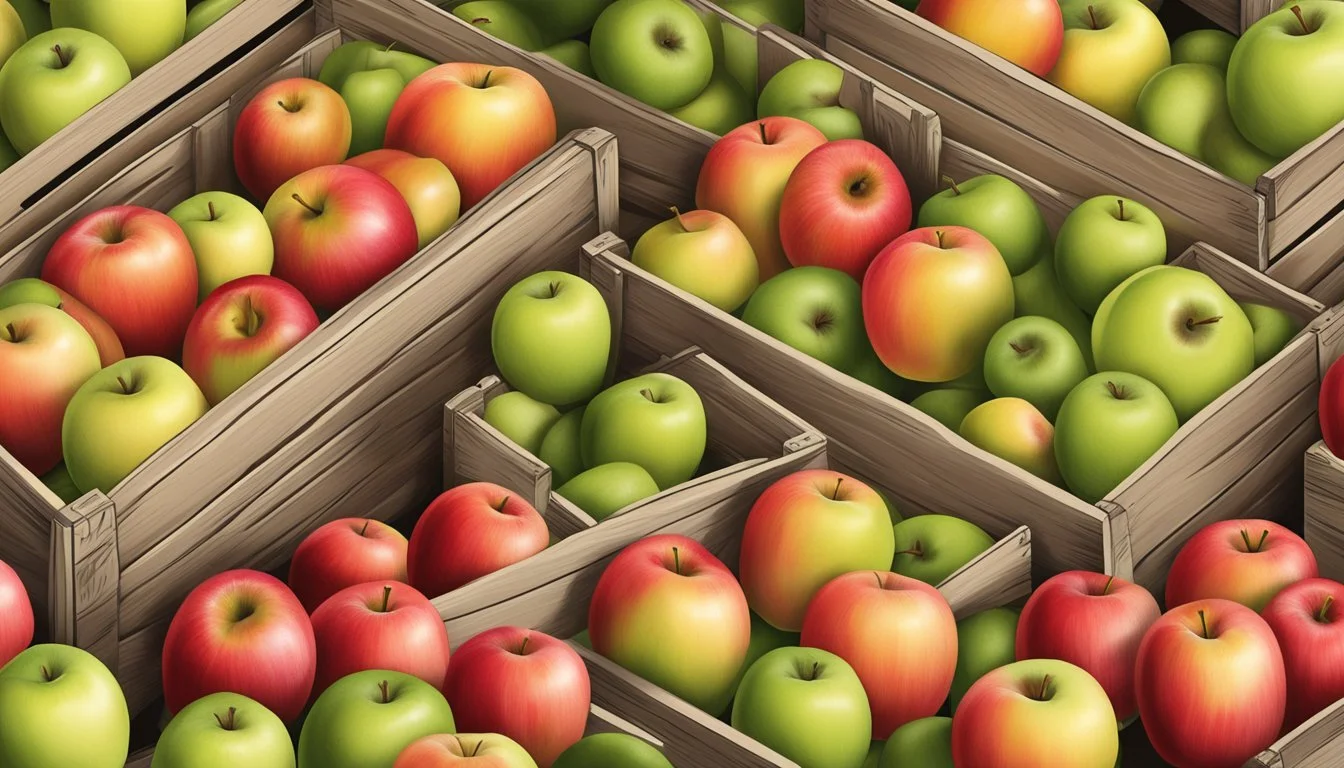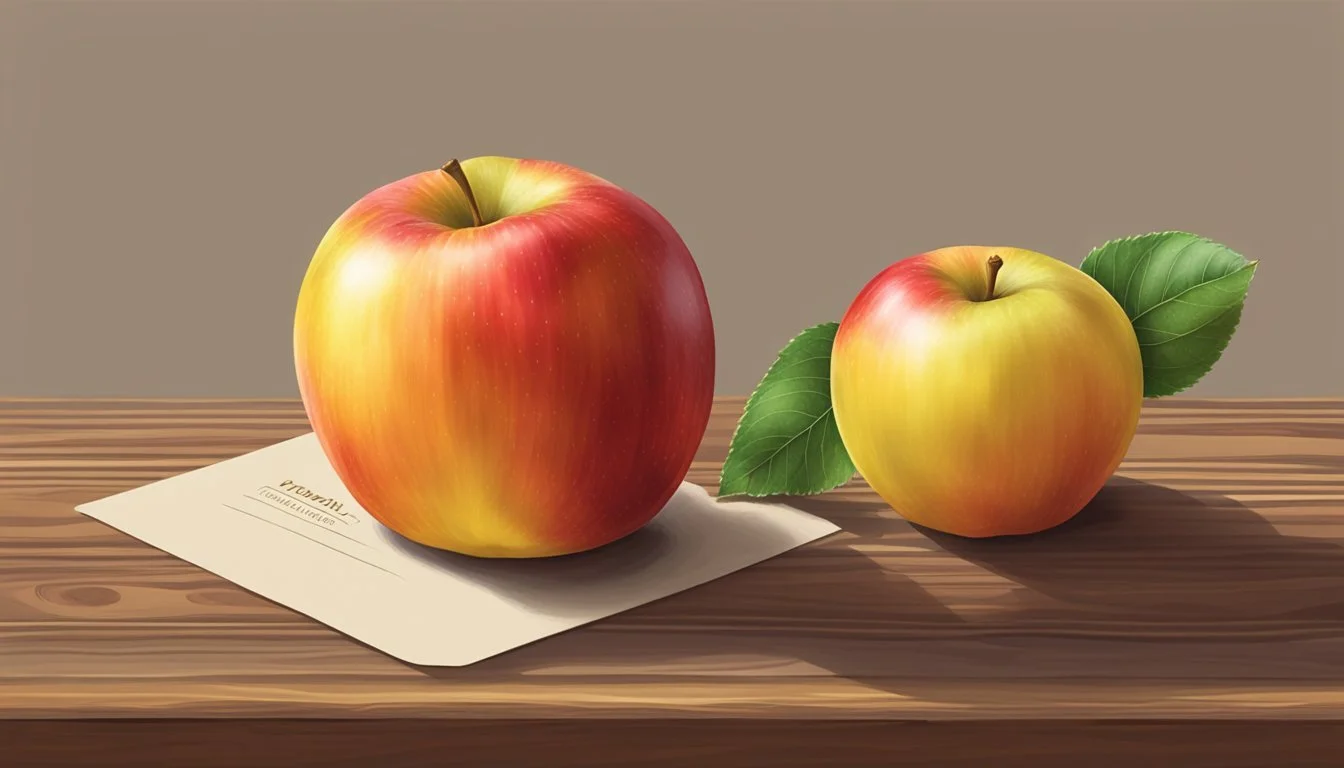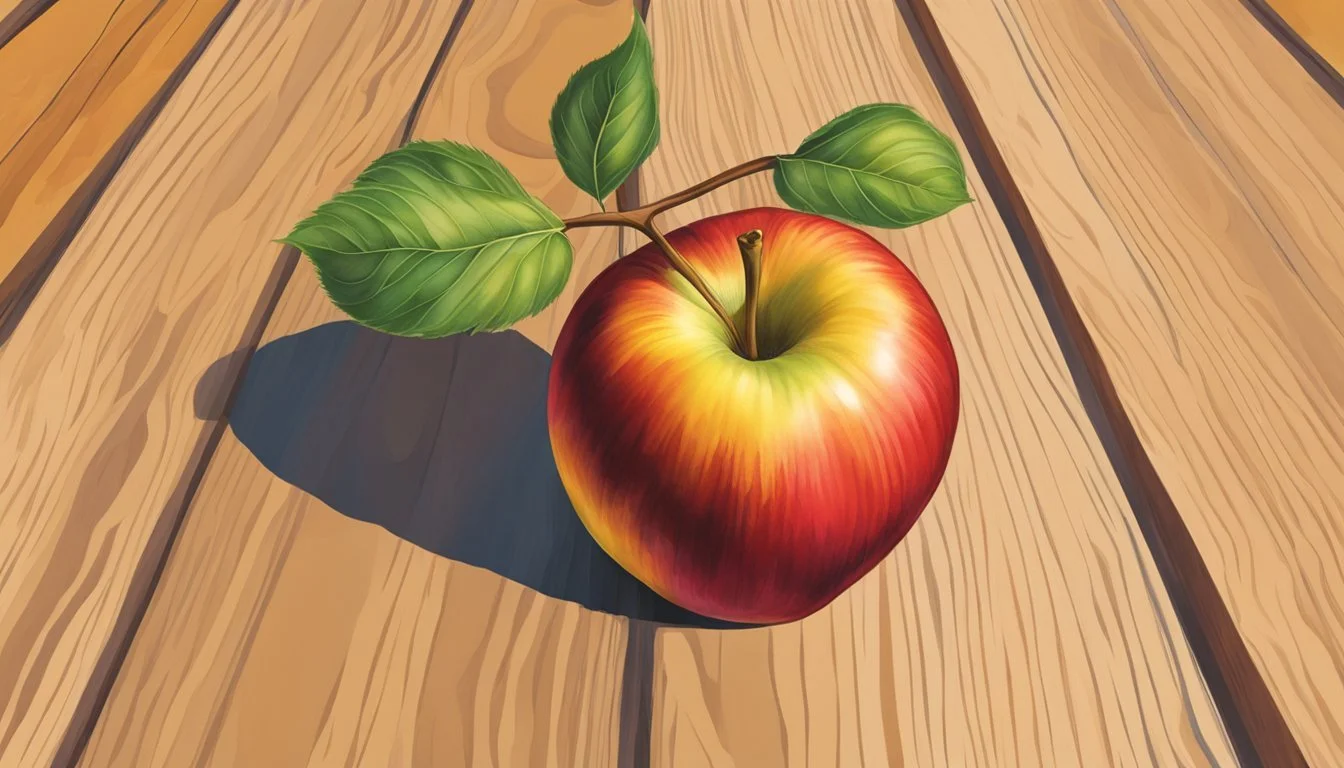How to Tell if a Honeycrisp Apple is Ripe
Selecting the Sweetest, Crispiest Fruit
Honeycrisp apples are prized for their crisp texture and balanced sweet-tart flavor, making them a favorite among apple enthusiasts. Knowing when these coveted fruits are ripe for picking is key to enjoying them at their best. While Honeycrisp apples typically reach ripeness in mid-September, they may exhibit subtle cues as to their maturity. The apples should display a predominantly red skin with some green undertones, avoiding those that have turned yellow which may indicate overripeness.
To ensure you're getting a perfectly ripe Honeycrisp apple, there are specific signs that can guide you. A ripe Honeycrisp will come off the tree easily when flipped upside down, a natural indication of readiness. The apple should be large, usually 2 to 3.5 inches in diameter, and feel firm to the touch. Even in the grocery store, where apples have already been harvested, these characteristics remain reliable indicators of freshness and ripeness. It is important to handle the fruit gently to maintain its quality, as Honeycrisp apples are known for their delicate skin and flesh.
Key Takeaways
Ripe Honeycrisp apples are distinguished by their easy detachment and a mix of red skin with green hues.
Proper handling and selection of Honeycrisp apples ensure the enjoyment of their optimal flavor and texture.
Honeycrisp apples offer a unique balance of sweetness and tartness, setting them apart from other apple varieties.
Identifying Ripe Honeycrisp Apples
When selecting a Honeycrisp apple, it’s crucial to assess its color, firmness, and aroma for signs of peak ripeness. These indicators ensure a perfect balance of flavor and texture.
Color and Appearance
Fully ripe Honeycrisp apples showcase a rich red color with patches of golden background or yellow undertones. It's not uncommon for ripe apples from the outer edges of the tree to present a more vibrant color compared to those from the inner canopy. Additionally:
Background color: Look for a yellow or golden hue
Overcolor: A pronounced red blush indicates higher sunlight exposure and increased ripeness
Firmness and Texture
The optimal Honeycrisp apple has a firm and crisp texture, providing a satisfying crunch when bitten into. To test for ripeness, one should:
Gently press: The skin should resist pressure and not feel soft or mealy
Handle with care: Ripe Honeycrisp apples are still delicate and can bruise easily
Aroma and Flavor
Ripe Honeycrisp apples exude a subtle, sweet aroma that hints at the flavor contained within. They strike a delightful flavor balance that is both sweet and slightly tart, with a juicy interior. Consider these sensory cues:
Aroma: A pleasant and sweet fragrance is often a reliable indicator of ripeness
Tasting: Sampling a small piece can confirm the perfect blend of sweetness and acidity
Optimal Picking Time for Honeycrisp Apples
Selecting the ideal moment for harvesting Honeycrisp apples is critical for achieving the best balance of sweetness and texture. These apples have a precise window of ripeness that, when hit correctly, results in a deliciously crisp fruit.
Seasonal Harvest Calendar
Honeycrisp apples typically reach their peak ripeness in mid-September. The window for optimal harvest can vary depending on regional climate conditions, but growers generally aim for this period to gather the fruits at their best.
Early September: Begin monitoring for signs of ripeness.
Mid-September: Peak harvest time for most regions.
Late September: Late harvest may still yield ripe apples, but risk of overripeness increases.
Signs of Maturity on the Tree
It is important to recognize the visual and tactile cues that Honeycrisp apples give when they are ready to be picked:
Coloration: The skin of the apple will have a rich red hue with some green undertones.
Ease of Picking: A ripe Honeycrisp apple will detach easily from the tree, often popping right off onto the picker's hand with an upward twist.
Taste Test: If unsure, growers may sample an apple for sweetness and firmness as a true indicator of ripeness.
The Science Behind Honeycrisp Apples
This section delves into the cultivation history of Honeycrisp apples, their unique genetic characteristics, and how cross-pollination and growth play a vital role in their development.
Cultivation History
Honeycrisp apples are the work of meticulous cultivation, having been developed by the University of Minnesota. Introduced to the market in 1991, the objective was to create an apple with exceptional crispness and a balanced sweet-tart flavor. Researchers combined the best traits of previous apple varieties to achieve a new standard in both texture and taste.
Genetic Characteristics
The Honeycrisp apple is distinguished by its unique genetic makeup. It owes its unusually crisp texture to the cellular composition that is thought to be larger than in other apples. DNA testing confirms the specific genetic combinations that give these apples their characteristic firmness and juiciness. The Honeycrisp's DNA provides insights into its hardiness in cold climates, a trait originating from the apple's Minnesota origins.
Cross-Pollination and Growth
Cross-pollination is essential for the growth of Honeycrisp apples as they cannot pollinate themselves. Instead, they rely on the pollen from other apple varieties to bear fruit. This process not only contributes to a successful harvest but also supports genetic diversity within the cultivar. The University of Minnesota emphasizes that careful monitoring of cross-pollination practices ensures the consistent quality and growth of Honeycrisp apples, which are now enjoyed globally.
Storing Honeycrisp Apples for Longevity
Proper storage techniques are crucial for maintaining the quality and extending the shelf life of Honeycrisp apples. This section provides concrete steps on ideal conditions for storage and methods to prevent spoilage.
Ideal Storage Conditions
To maximize longevity, Honeycrisp apples should be stored at temperatures between 32-40°F (0-4°C) with a relative humidity of 90-95%. Supermarkets and grocery stores typically manage this climate in commercial storage facilities. Home storage can mimic these conditions in a refrigerator or a root cellar. It's essential to keep these apples away from ethylene gas producers like bananas and tomatoes, as the gas can accelerate the ripening and subsequent decline of apples.
Temperature and Humidity:
Temperature: 32-40°F (0-4°C)
Humidity: 90-95%
Apples should not be left at room temperature for more than 1-2 weeks as this will lead to a quicker decline in freshness and texture. In controlled atmospheres with specific gas concentrations, Honeycrisp apples can be stored for six to seven months, ensuring a supply of fresh fruit well beyond the harvest season.
Prevention of Spoilage
Regular inspection is necessary to prevent damage and spoilage that can be caused by bruising or the presence of an already decaying apple. Store Honeycrisp apples in a manner that allows for ample airflow between them, which can be achieved by using crates or baskets. Isolating damaged apples promptly ensures the rest remain unaffected.
Regular Checks: Weekly inspections for spoilage
Airflow: Use crates or baskets to maintain good circulation
Separation: Keep apples away from ethylene-producing fruits
Implementing these storage techniques will help maintain the crispness and flavor of Honeycrisp apples for an extended period, providing consumers with high-quality fruit longer after the harvest ends.
Benefits and Nutritional Profile
Honeycrisp apples are not only a delicious variety of fruit known for their crisp texture and juicy quality, but they also offer impressive health benefits and substantial nutritional content.
Health Benefits
Honeycrisp apples provide numerous health advantages. One notable benefit is their contribution to heart health. The consumption of Honeycrisp apples can support the lowering of cholesterol levels due to their high amount of soluble fiber. This type of fiber binds with cholesterol in the digestive system, which helps prevent its absorption into the bloodstream.
Dietary Fiber and Nutritional Content
Nutritional Content of a Medium-Sized Honeycrisp Apple (Approximately 100g):
Calories: 52 kcal
Protein: Less than 1g
Fat: 0g
Carbohydrates: 14g
Fiber: 3g
They are also a low-fat option with zero grams of fat. Plus, their significant fiber content, which is about 3 grams per medium-sized apple, adds to a healthy digestive tract and aids in sustained fullness, which can be beneficial for weight management. The carbohydrates found in Honeycrisp apples are primarily composed of natural sugars, which provide a clean and quick source of energy.
Pairing and Cooking With Honeycrisp Apples
Honeycrisp apples are renowned for their crisp texture and balanced sweetness, making them versatile for both raw and cooked preparations. They retain their shape well during cooking, which makes them ideal for recipes where a distinct apple presence is desired.
Culinary Uses
When cooking, the Honeycrisp apple's robust structure and subtle acidity make it excellent for dishes that require baking or sautéing. They perform exceptionally well in recipes such as apple pies, where they contribute both a tender bite and a hint of tartness. For homemade applesauce, Honeycrisp apples bring a natural sweetness that often requires less added sugar.
Pies and Tarts: The Honeycrisp's ability to hold its shape under heat keeps desserts looking and tasting delightful.
Applesauce: Their natural sweetness and slight acidity yield a flavorful applesauce with a desirable texture.
Recipes and Pairing Recommendations
A classic Honeycrisp Apple Pie recipe might include thinly sliced apples mixed with ingredients like:
Granulated sugar or maple syrup
Ground cinnamon and nutmeg for warmth
A dash of lemon juice for balance
These ingredients highlight the Honeycrisp's flavor without overpowering it. Furthermore, for a healthy snack, one can pair sliced Honeycrisp apples with various nut butters, providing a satisfying crunch complemented by creamy richness.
Salad Pairings:
Fall Harvest Salad: Honeycrisp apple slices add a refreshing juiciness to salads that include components like squash, nuts, or robust cheeses.
Whether incorporating into baked goods or using as a fresh pairing, Honeycrisp apples remain an adaptable ingredient in a vast array of culinary applications.
Selecting Honeycrisp Apples at the Store
When selecting Honeycrisp apples from the grocery store, it is important to assess both the visual appeal and the firmness of the fruit. These apples are known for their premium quality, marked by a sweet taste and satisfying crunch.
Visual Inspection
Color: Look for a vibrant mix of red and green on the skin, an indicator of ripeness. The surface should be free from bruising and excessive blemishes, although small speckles are normal.
Shape: A ripe Honeycrisp apple should be round and plump. Irregular shapes are sometimes normal, but they should not be extreme as this can impact the crunch and texture.
How to Test Firmness
Gentle Pressure: Apply gentle pressure to the apple. The skin should yield slightly but remain firm. If the flesh feels hard, the apple may not have reached peak ripeness. Conversely, if the area feels mushy, it is overripe.
Weight: Heft the apple in hand; it should feel solid and heavy for its size. A lighter apple might indicate a lack of juiciness, which is critical for that trademark Honeycrisp sweet and crunchy experience.
Understanding the Popularity of Honeycrisp Apples
Introduced in the 1990s and having gained a significant following, Honeycrisp apples have become notably popular due to their distinct taste and texture which set them apart from other varieties like Sweetango, Cosmic Crisp, and Ambrosia.
Market Demand and Price
Market Demand: Honeycrisp apples have seen a consistent increase in market demand across America, proving to be one of the most sought-after apple varieties.
Price: Due to their popularity and production costs, Honeycrisp apples often carry a higher price, retailing around $4 per pound, which reflects both their demand and the cost of cultivating them compared to other varieties.
Consumer Preferences
Taste Profile: Consumers often prefer Honeycrisp apples for their explosive juiciness and perfect balance of sweetness and tartness. This positions them as a loved choice for both fresh and cooked consumption.
Texture: The crisp texture is another compelling feature, often cited as a standout characteristic that heightens the eating experience of these apples.
Comparisons With Other Apple Varieties
In discerning the ripeness of Honeycrisp apples, it's helpful to contrast their characteristics with other popular varietals. The following subsections will provide a pointed comparison to guide consumers and connoisseurs in selecting the ideal apple variety for their specific needs.
Honeycrisp vs. Other Varietals
Honeycrisp apples are celebrated for their crisp texture and explosively juicy flesh, making them stand apart from other varieties. Here are comparisons with some well-known apple types:
McIntosh: McIntosh apples have a softer texture compared to the firmness of Honeycrisps. They also have a more tart flavor, which may not be as universally appealing as the balanced sweetness of the Honeycrisp.
Golden Delicious: These apples are sweet with a thinner skin, but lack the crispness of Honeycrisps. They tend to bruise more easily and may not store as well.
Red Delicious: Beauty is the hallmark of Red Delicious, yet their texture can be mealy, contrasting greatly with the crispness that Honeycrisp fans adore.
Gala: A Gala apple is sweet like Honeycrisp, but offers a milder flavor, and is not as crisp, impacting its freshness perception.
Pink Lady: Compared to Honeycrisps, Pink Ladies have a distinctive tang and firmness, yet they still deliver a satisfying crunch.
Granny Smith: This apple is significantly tarter and also denser, which some baking recipes prefer for structure.
Choosing the Best Variety for Your Needs
When selecting the best apple variety, consider the following:
Fresh Consumption: If one desires an apple for fresh eating, Honeycrisps are ideal for their refreshing juiciness.
Baking: For pies and pastries, a denser apple like the Granny Smith may hold up better, as Honeycrisp can become too soft when cooked.
Salads: Honeycrisps add a sweet crunch to salads, but so can Pink Ladies or Galas if less sweetness is desired.
Storage: Golden Delicious and McIntosh may not store as well as Honeycrisps, which have a longer shelf life when kept in proper conditions.
In summary, Honeycrisp apples are a solid choice for those who prefer a sweet, juicy, and crisp apple. However, other varietals like McIntosh, Granny Smith, or Red Delicious may be more suitable for specific culinary uses or taste preferences.





